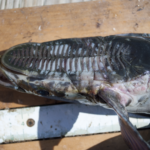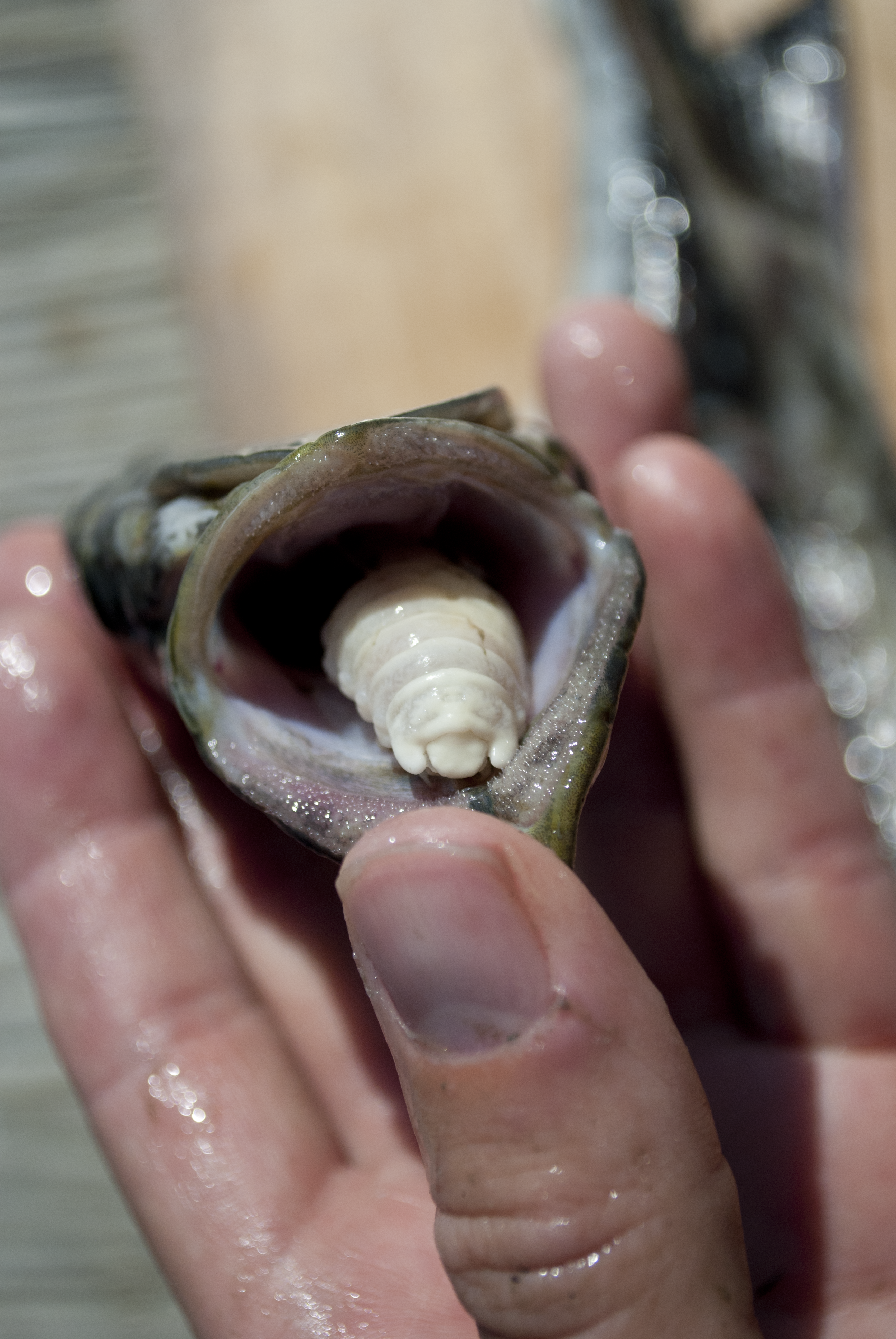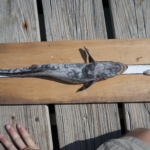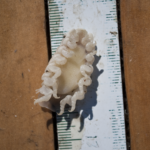I was lucky enough to catch a ride on a commercial gill net boat recently, and while the fishermen were targeting spot (Leiostomus xanthurus), I was hoping to add some species and photographs to our collection. The trip was your typical Core Sound gill net trip, with a few hundred pounds of spot, butterfish (Peprilus triacanthus), kingfish (Menticirrhus spp.), cobia (Rachycentron canadum), spotted sea trout (Cynoscion nebulosus), and what I believe to be a live sharksucker (Echeneis naucrates). Unfortunately the condition of the fish, after 12 hours in the net, made it more difficult to identify than I had hoped. Nonetheless, I thought I would take a side by side shot of a small cobia next to the sharksucker as a way of showing the differences between these two often confused fishes.

Turns out that the condition of both fishes was too poor to really help with teaching identification, but while preparing for the shot, I noticed another interesting animal:
This is a species of parasitic isopod (think rolly-polly), and although I haven’t the slightest clue as to which species, I can tell you that it plays an identical role to another similar isopod, Cymothoa excis. For the uninitiated, this is a parasitic isopod that attaches itself to the base of the tongue, and then sucks blood from the tongue causing it to atrophy. Once the tongue is out of the way, the isopod then sets up shop, attaches to the stub, and replaces the tongue. From this point onward, the fish will use the isopod as it would its own tongue.

In the south eastern US, some anglers refer to Atlantic Menhaden (Brevoortia tyrannus) as “bug mouths,” as they are often infected with a similar parasitic isopod.
This particular isopod survived the death of the fish, and attempted to escape. Whether or not it is capable of surviving on its own, I don’t know. However, in case you ever come across one and have the crazy idea to handle it, be prepared, they are not only very quick to latch on, but very capable of biting you too! It doesn’t tickle.





Figure A. Female Jack Isopod
NUMBER: 20140601
SPECIES: Jack Isopod, Cymothoa oestrum (Linnaeus, 1758)
DISTINGUISHING: Only 2 Cymothoa in region. This one has rounded shoulders (peronite 1 projections)
LOCATION: North Carolina, USA (Smith, 2014)
COLLECTION: Scott Smith on commercial gillnet vessel. We have collected many fishes and isopods in this fashion.
HOST: Common Remora, Remora remora (Linnaeus, 1758)
IMPORTANCE: New host record. Not too surprising since it attaches to many hosts of this isopod but still new and across-host infection.
PHOTOGRAPH: by Scott Smith. This was placed online without restrictions (Anonymous, 2021). Still we should credit the collector and photographer.
COMMENT: Absence of Atlantic Croakers, Microponias undulatus (Linnaeus, 1766), in catch was interesting. EHW likes them.
DATE: 1 June 2014
OBSERVERS: Scott Smith; Dr. Ernest H. Williams, Jr.;[2,3,5,6] and Dr. Lucy Bunkley-Williams[2,4,5,7]
REFERENCES:
Anonymous. 2021. The Fishes of North Carolina. https://ncfishes.com/knowledge-base/parasitic-isopod/NCFishes.com.
Smith, S. 2014. Parasitic isopod. The fishes of North Carolina. NCFishes.com. https://ncfishes.com/the-sharksucker-and-the-isopod/
Williams, E. H., Jr., L. Bunkley-Williams, and S. Smith. 2023. New host record and across-host infection of Jack Isopod, Cymothoa oestrum (Linnaeus), in the Common Remora, Remora remora (Linnaeus). iNaturalist #150188413, 1 March 2023 (open access), ResearchGate [804].
FOOTNOTES:
[1]Identification was peer-reviewed, text edited and usually condensed. The original text is in our reprint #804 and ResearchBase. [2]Extraordinary Professors, Potchefstroom Campus, North-West University, South Africa; Adjunct Professors, Research Field Station, Florida Gulf Coast University, 5164 Bonita Beach Road, Bonita Springs, FL 34134; [4]Dept. Marine Sciences, University of Puerto Rico (retired); [5]Dept. Biology, UPR (retired); [6]920 St. Andrews Blvd, Naples, FL 34113-8943; [7]e-mail ermest.williams1@upr.edu; cell 239-227-3645, ORCID 0000-0003-0913-3013; [8]Cell 787-467-2179, e-mail lucy.williams1@upr.edu, ORCID 0000-0003-1390-911x
Figure A. Jack Isopod
Figure B,C. Host
Figure B. Host Figure C. Host
Thank you for the details Dr. Williams, it’s always nice to have an expert review these for us!